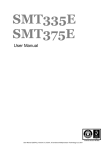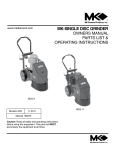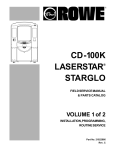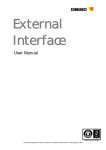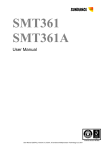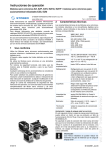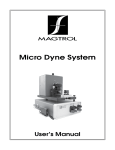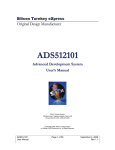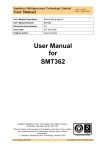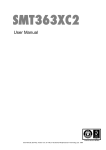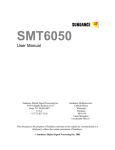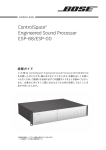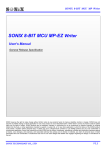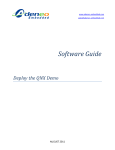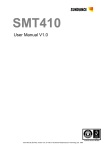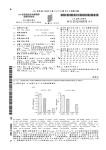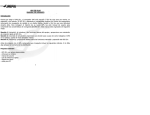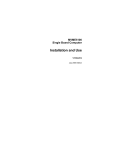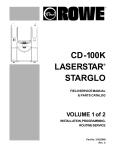Download SMT335 User Manual - Sundance Multiprocessor Technology Ltd.
Transcript
SMT335 SMT375 User Manual User Manual (QCF42); Version 3.0, 5/2/01; © Sundance Multiprocessor Technology Ltd. 2001 Version 3.0 Page 2 of 34 SMT335 User Manual Revision History Date Comments Engineer Version 08/05/00 Comm port J.V. 0.1 12/06/00 SDB J.V. 0.2 10/07/00 Pre-release version J.V. 0.9 26/07/00 First version J.V. 1.0 27/07/00 Typing error corrected. (Comm Port status) J.V. 1.1 08/08/00 New Burst mode selection from CP status J.V. 1.2 09/08/00 Output FIFO status displays how many words J.V. can be sent 1.3 14/08/00 Global register and Interrupt control register J.V. reordered. (Need Bootv1.2) 1.4 03/09/00 SDB naming corrected to A and B. J.V. 1.5 Global register display the interrupt status Global Bus modification for DMA use. Comm port drawing modified Boot code Version 1.4 FPGA Firmware Version 2.0 (top335V2_0_6.dat) 14/09/00 NMI routing selection added. J.V. 1.6 18/09/00 Global Bus transfer example corrected J.V. 1.7 10/10/00 Global Bus wait state and bus sharing feature J.V. added. 1.8 Comm-port status register: OCPRDY and ICPRDY moved to allow FIFO depth expansion. Firmware version 2.5.6 27/10/00 Global Bus wait state increased to 15. Cf. J.V. Control register. Comm-port status register: Full reset bit added for crash recovery. Firmware version 2.7.6 1.9 Version 3.0 09/11/00 Page 3 of 34 SMT335 User Manual Documentation added for DMA transfers J.V. 2.0 J.V. 2.1 J.V. 2.2 J.V. 2.3 FPGA I/O Slew rate changed to S_12. Firmware version 2.8.6 07/12/00 SDB interrupt flags modified. Global bus tri-state signal not latched. Global bus flag cleared when transfer direction is changed. Comm-port reply disabled during token exchange. Firmware version 2.9.6 11/12/00 SDB Memory mapping updated. Firmware version 3.0.6 24/01/01 Manual updated with quality template. Timer routing detailed. Comm-port drawing corrected. Reprogramming and version control described. SDB Interrupt detailed. Bug fixed. SDB handling Comm-port bug reported. Firmware version 3.3.6 13/4/01 General overhaul and clarification PSR 3.0 30/8/01 Power consumption and reset timing added. J.V. 3.1 Global bus additional feature. Synchronisation J.V. with carrier board on SMT328 and SMT310. 3.2 Value of Bit 12-13 of the global control register explained. 11/04/02 External trigger SMT118. for ADC acquisition for Fix for Comm-port Burst mode selection between threads in bi-directional transfer. Firmware version 3.11.6 Version 3.0 15/05/02 Page 4 of 34 SMT335 User Manual IIOF Interrupt description. J.V. 3.3 J.V. 3.4 Global bus BUSY bit description Interrupt control register 6 address corrected. Global bus transfers description for SMT310 family. Firmware version 3.11.6 30/01/03 Restructure of the document. Double buffered global bus. Will require code change if transfer via dma were used. SDB dma synchronisation software change required. changed no Firmware version 3.13.6 It is important that you use the correct version of the firmware; you should use firmware version 3.13.6 or later. Check your firmware revision number with the program read_version_335.out and ask for a more recent version if necessary. E-mail: [email protected] Version 3.0 Page 5 of 34 SMT335 User Manual Table of Contents Revision History............................................................ Error! Bookmark not defined. Contacting Sundance ................................................... Error! Bookmark not defined. Notational Conventions................................................ Error! Bookmark not defined. SMT335....................................................................Error! Bookmark not defined. Register Descriptions ...............................................Error! Bookmark not defined. Outline Description....................................................... Error! Bookmark not defined. Block Diagram............................................................... Error! Bookmark not defined. Architecture Description .............................................. Error! Bookmark not defined. TMS320C6201/6701....................................................... Error! Bookmark not defined. Boot Mode................................................................Error! Bookmark not defined. EMIF Control Registers ................................................ Error! Bookmark not defined. SBSRAM ..................................................................Error! Bookmark not defined. SDRAM ....................................................................Error! Bookmark not defined. FLASH......................................................................Error! Bookmark not defined. Version control ............................................................. Error! Bookmark not defined. Reprogramming the firmware and boot code ............ Error! Bookmark not defined. Interrupts ....................................................................... Error! Bookmark not defined. Communication ports................................................... Error! Bookmark not defined. Data rates ...................................................................... Error! Bookmark not defined. SDB ................................................................................ Error! Bookmark not defined. SDB ................................................................................ Error! Bookmark not defined. SDB update..............................................................Error! Bookmark not defined. SDB Clock selection.................................................Error! Bookmark not defined. Global bus ..................................................................... Error! Bookmark not defined. Note for SMT310, SMT310Q, SMT300, SMT300Q ..Error! Bookmark not defined. Clock Speed .................................................................. Error! Bookmark not defined. LED Setting ................................................................... Error! Bookmark not defined. LED Register............................................................Error! Bookmark not defined. CONFIG & NMI............................................................... Error! Bookmark not defined. Timer .............................................................................. Error! Bookmark not defined. IIOF interrupt ................................................................. Error! Bookmark not defined. Version 3.0 Page 6 of 34 SMT335 User Manual Code Composer ............................................................ Error! Bookmark not defined. Application Development............................................. Error! Bookmark not defined. Operating Conditions ................................................... Error! Bookmark not defined. Safety .......................................................................Error! Bookmark not defined. EMC .........................................................................Error! Bookmark not defined. General Requirements .............................................Error! Bookmark not defined. Power Consumption .................................................Error! Bookmark not defined. Serial Ports.................................................................... Error! Bookmark not defined. C6201 Memory Map ...................................................... Error! Bookmark not defined. Flash Access................................................................. Error! Bookmark not defined. Virtex Memory Map ....................................................... Error! Bookmark not defined. Jumpers......................................................................... Error! Bookmark not defined. JP1: Clock speed select ...........................................Error! Bookmark not defined. JP2: Serial port header.............................................Error! Bookmark not defined. SDB Pin-Out .................................................................. Error! Bookmark not defined. Virtex layout .................................................................. Error! Bookmark not defined. Virtex Pin-Out................................................................ Error! Bookmark not defined. Bibliography.................................................................. Error! Bookmark not defined. Index .............................................................................. Error! Bookmark not defined. Contacting Sundance You can contact Sundance for additional information by sending email to [email protected] Version 3.0 Page 7 of 34 SMT335 User Manual Notational Conventions SMT335 Throughout this document the term SMT335 will usually be used to refer to both the SMT335 and the SMT375. It should be clear from the context when a distinction is being drawn between the two types of module. Register Descriptions The format of registers is described using diagrams of the following form: 31–24 23–16 15–8 7–0 R,00000000 R,10000000 OFLAGLEVEL R,00000000 RW,10000000 The digits at the top of the diagram indicate bit positions within the register and the central section names bits or bit fields. The bottom row describes what may be done to the field and its value after reset. Shaded fields are reserved and should only ever be written with zeroes. R Readable by the CPU W Writeable by the CPU RW Readable and writeable by the CPU Binary digits indicate the value of the field after reset. Version 3.0 Page 8 of 34 SMT335 User Manual Outline Description The SMT335 is a C6000-based size 1 TIM offering the following features: SMT335: TMS320C6201 processor running at 200MHz SMT375: TMS320C6701 processor running at 166MHz Six 20MB/s communication ports (comm.-ports) 512KB of fast SBSRAM, 16MB of SDRAM 512KB Flash ROM for boot code and FPGA programming Global expansion connector High bandwidth data I/O via 2 Sundance Digital Buses (SDB). Version 3.0 Page 9 of 34 SMT335 User Manual Block Diagram SDRAM SBSRAM 4M x 32 128K x 32 FLASH 512K x 8 C6201 1600MIPS Address(16),Data(32),Control=12 23pins GLOBAL BUS COMM PORTS SDB User applications 23pins SDB SDB Virtex Address,Data,Control=75pins 4xComms=48pins 2xComms,Tclk,Clocks,Ints=33pins GLOBAL SECONDARY PRIMARY Version 3.0 Page 10 of 34 SMT335 User Manual Architecture Description The SMT335 TIM consists of a Texas Instruments TMS320C6201 running at 200MHz while the SMT375 has a TMS320C6701 running at 166MHz. Modules are populated with 512KB of synchronous burst SRAM (SBSRAM) and 16MB of synchronous DRAM (SDRAM), giving a total memory capacity of 16.5MB. A Field Programmable Gate Array (FPGA) is used to manage global bus accesses and implement six communication ports and two Sundance Digital Buses. Version 3.0 Page 11 of 34 SMT335 User Manual TMS320C6201/6701 Bother processors will run with zero wait states from internal SRAM, the TMS320C6201 at 200MHz and the TMS320C6701 at 166MHz. An on-board synthesiser from MicroClock provides the clock used for the C6000; jumpers on the TIM allow you to select clock speeds from 118MHz to 200MHz. Unlike similar TIMs based on the TMS320C4x, there is no option to provide an external clock source. The TIM configuration feature is fully implemented. This provides a single opencollector line that can be held low until software configuration has been completed. Boot Mode The SMT335 is configured to use the following boot sequence each time it is taken out of reset: 1. The processor copies a bootstrap program from the first 32KB of the flash memory into internal program RAM starting at address 0. 2. Execution starts at address 0. The standard bootstrap supplied with the SMT335 then performs the following operations: 1. All relevant C6000 internal registers are set to default values; 2. The FPGA is configured from data held in flash memory and sets up the communication ports, the global bus and the Sundance Digital Buses. This step must have been completed before data can be sent to the comm-ports from external sources such as the host or other TIMs; 3. A C4x-style boot loader is executed. This will continually examine the six communication ports until data appears on one of them. The bootstrap will then load a program in boot format from that port; the loader will not read data arriving on other ports. See “Application Development” on page Error! Bookmark not defined. for details of the boot loader format; 4. Finally, control is passed to the loaded program. The delay between the release of the board reset and the FPGA configuration is around 280ms for a SMT335 (200MHz clock) and 330ms for a SMT375 (166MHz). The worse case is with a board clocked at 118MHz (no jumper fitted) in which case the FPGA will be configured 480ms after the reset is released. A typical time to wait after releasing the board reset is 500ms. Version 3.0 Page 12 of 34 SMT335 User Manual EMIF Control Registers The C6000 contains several registers that control the external memory interface (EMIF). There is one global control register and a separate register for each of the memory spaces CE0 to CE3. A full description of these registers can be found in the C60000 Peripherals Reference GuideError! Reference source not found.Error! Reference source not found.[Error! Reference source not found.]. The standard bootstrap will initialise these registers to the following values: GC (global control) 0x00003779 0x0000377D For half speed SBSRAM For full speed SBSRAM (default) CE0 0x00000040 Indicates SBSRAM CE1 0x30FF3F03 Defines asynchronous memory timings CE2 0x00000030 Indicates SDRAM CE3 0x00000030 VIRTEX FPGA Note: Bits 12&13 of the Global control register are listed as 'reserved' in the current TI documentation. With earlier versions of the C6000 silicon, these 2 bits controlled the polarity of two clock outputs from the device. To maintain code compatibility for all of our version modules, we have left our documentation with bits 12&13 set. SBSRAM Memory space CE0 is used to access 512KB of zero wait-state SBSRAM over the C6000 external memory interface (EMI). SBSRAM is normally set to run at the speed of the C6000 core clock, but the GC register can be used to reduce this to one half of the core clock speed. The appropriate setting has to be determined in conjunction with the C6000 core speed and the external memory speed; refer to Clock Speed on page Error! Bookmark not defined. for further details. SDRAM Memory space CE2 is used to access 16MB of SDRAM over the EMI. The SDRAM operates at one half of the core clock speed. FLASH A 512KB Flash ROM device is connected to the C6000 EMI. This device is accessed, a byte at a time, with word addresses from 0x0140 0000 to 0x015F FFFF using strobe CE1 in 32-bit asynchronous mode. Each 32-bit load will give 8 bits of data in bits 7–0 of the result; the state of bits 31–8 is undefined. Version 3.0 Page 13 of 34 SMT335 User Manual The ROM holds boot code for the C6000, configuration data for the FPGA, and optional user-defined code. A software protection algorithm is in place to prevent programs accidentally altering the ROM’s contents. Please contact Sundance for further information about reprogramming this device [Error! Reference source not found.Error! Reference source not found.Error! Reference source not found.Error! Reference source not found.]. Version control Revision numbers for both the boot code and FPGA firmware are stored in the Flash ROM during programming as zero-terminated ASCII strings. These revision numbers are located using byte offsets from the base of the Flash ROM (0x01400000). The offsets are held as 4-byte words at the end of the ROM: 0x015FFFF8 for the FPGA firmware offset and 0x0147FFFC for the boot code offset. The distribution disk contains a program, read_version_335.out, in the directory Reprogramming\version_control. You can load and run this program from code composer to display both the FPGA and boot code version numbers. Reprogramming the firmware and boot code The Reprogramming\flash directory of the distribution disk contains a utility that will run under code composer and program the flash ROM. The utility is called pflashx_y_z.out, where x_y_z is the FPGA version number. You load the utility with the code composer “Load Program” option from the “File” menu. Once the program has loaded, you should select “Run” from the “Debug” menu. The reprogramming process takes a minute or so and should display “Flash programming complete” when it has finished. After the program has run you should “Halt” the processor from the “Debug” menu and select “Run Free”. To confirm that the programming has been successful you should use the Sundance Server to reset the board and execute one of the supplied test programs. A detailed description of the reprogramming process is available as an Application Note [Error! Reference source not found.], which will also help you to develop your own core in the FPGA. Version 3.0 Page 14 of 34 SMT335 User Manual Interrupts See general firmware description Communication ports The SMT335 provides six comm-ports. See general firmware description Data rates When using the communication links of a C6000 you must remember that the links share a single bus, so the performance you get will depend on the way you sequence bus accesses. C6201 can read at 100MHz from external to internal memory; the rate for the C6701 is 83MHz. If you want to store in external memory then the rate achievable are divided by two as the read and writes share the same bus, which means respectively 50MHz and 41MHz. The C6000 DMA channels are not efficient when moving data between two external memory areas sharing a common bus; the transfer will take place a word at a time and not in more efficient bursts. This is why it may not be advisable to use DMA to transfer data directly between external memory and a communication link. Performance can be greatly improved by using an intermediate buffer in internal memory. SDB The SMT335 provides two Sundance Digital Buses (SDBs). See general firmware description SDB update You should be aware that revisions of the SDB before V3.0.6 have a significantly different treatment of the status flags and a different address is used to program the SDB flag levels for input and output. When upgrading from versions before V3.0.6, you will need to change the code for flag programming and accessing the status bits. You should use version V3.3.6 or above because previous versions could generate spurious interrupts on input. SDB Clock selection At any time you can change the speed of an SDB clock by altering SDBCLK. Version 3.0 Module SMT335 SMT375 Page 15 of 34 SDBCLK Clock Speed 0 50MHz 1 100MHz 0 41MHz 1 83MHz SMT335 User Manual Global bus The SMT335 provides one global bus interface. See general firmware description The latest global bus interface is double buffered for dma so that it can read ahead the next buffer while the first one is being read by the DSP. Similarly a buffer is being written while the previous one is being sent. The important thing is to set the global bus operation register before enabling the global bus interrupt on an external interrupt line so that the interrupt generated is the one relevant to the operation (read/write). This has changed for the SMT335 firmware as it used to need the dma event to be forced for a write and that the external interrupt was enabled before the operation register was set. This is the only change needed when updating from a version of the SMT335 prior to 3.13.6. Note for SMT310, SMT310Q, SMT300, SMT300Q Burst Transfer across a 1KBytes page boundary is only supported from version 3.13.6 of the firmware. To transfer over the PCI the global bus is set-up to be able to perform burst transfer across the PCI bridge chip. A burst transfer is happening whenever the global bus transfer size register is set to transfer more than one word at a time. During a burst a word is transferred on every clock cycle. The PC memory can be accessed through aperture 0 of the PCI Bridge but a burst transfer must not cross a 1KBytes boundary (256 words). This is because the page size of the bridge chip is 1KBytes. In other words burst transfer must always be ended on a page boundary. For example you should never burst from the pci address XXXXX3FCH to XXXXX400H. Address XXXXX400H would actually be targeting address XXXXX000H in the pci address space as the page accessed by this burst was in the address range XXXXX000H - XXXXX3FCH. To make sure a page crossing does not happen during burst access an address alignment has to be performed. The global bus transfer size has to be reduced not to Version 3.0 Page 16 of 34 SMT335 User Manual cross a page. For DMA it is advised to align the transfer on 256 words and then setup the DMA to transfer by bursts of 256 words to ensure no page boundary is crossed during burst. Version 3.0 Page 17 of 34 SMT335 User Manual Clock Speed You must consider EMIF device speeds when choosing the appropriate C6000 clock speed. Under most circumstances, the C6201 would be set to 200MHz and have an SBSRAM speed equal to the core speed; the C6701 would be set to 166MHz. See the description of jumper JP1 on page Error! Bookmark not defined.. C6000 clock SBSRAM SDRAM FPGA 133 166 200 200 133 166 100 200 67 83 100 100 67 83 100 100 LED Setting The SMT335 has 5 LEDs. LED 1 always displays the state of the FPGA DONE pin. This LED is off when the FPGA is configured (DONE=1) and on when it is not configured (DONE=0). This LED should go on when the board is first powered up and go off when the FPGA has been successfully programmed. If the LED does not light at power-on, check that you have the mounting pillars and screws fitted properly. If it stays on, the DSP is not booting correctly. The remaining LEDs can be controlled with the LED register. Writing 1 will illuminate the LED; writing 0 will turn it off. See general firmware description CONFIG & NMI See general firmware description Timer See general firmware description IIOF interrupt From version 3.11.6 of the firmware it is possible to generate pulses on the external interrupt lines of the TIM. See general firmware description Version 3.0 Page 18 of 34 SMT335 User Manual Code Composer This module is fully compatible with the Code Composer debug environment. This extends to both the software and JTAG debugging hardware including the SMT320V4, SMT327, SMT328 and TI’s XDS-510. Application Development You can develop code for SMT335/375 modules in several ways. The simplest is to use the Sundance SMT6000 Server Loader and its associated libraries. The Server Loader is an application that runs on a host PC under either Windows 98 or NT and allows you to run COFF-format applications. Modified forms of the TI rts library, one for the C6201 and one for the C6701, support standard C I/O. The Server Loader will read a .out file and convert it into C4x-style boot code which is then transmitted down a comm-port to the SMT335. The boot code is in the following format: Word1 1 6-word header Load Block 0x00003779 half speed SBSRAM 0x0000377D full speed SBSRAM (recommended) Words 2, 3, 4 0, 0, 0 Word 5 start address Word 6 0 Word 1 4*N: Length of load block (in bytes)2 Word 2 Destination address (external memory only) Next N words N data words Word 1 03 0 or more Load Blocks Terminator 1 A word is 32 bits 2 The length of each data block will be rounded up to a multiple of 4 bytes if necessary. 3 Effectively a zero-length Load Block Version 3.0 Page 19 of 34 SMT335 User Manual Operating Conditions Safety The module presents no hazard to the user. EMC The module is designed to operate within an enclosed host system that provides adequate EMC shielding. Operation within the EU EMC guidelines is only guaranteed when the module is installed within an appropriate host system. The module is protected from damage by fast voltage transients introduced along output cables from outside the host system. Short-circuiting any output to ground does not cause the host PC system to lock up or reboot. General Requirements The module must be fixed to a TIM40-compliant carrier board. The SMT335 TIM is in a range of modules that must be supplied with a 3.3v power source. In addition to the 5v supply specified in the TIM specification, these new generation modules require an additional 3.3v supply to be presented on the two diagonally-opposite TIM mounting holes. The lack of this 3.3v power supply should not damage the module, although it will obviously be inoperable; prolonged operation under these circumstances is not recommended. This module is not directly compatible with earlier generations of TIM motherboards, although the 3.3v supply can be provided from a separate source. It is, however, compatible with the latest generation of Sundance TIM carrier boards such as the SMT320V4 and subsequent versions (PCI), and SMT328 (VME), which present the 3.3v via conductive mounting pillars. Use of the TIM on SMT327 (cPCI) motherboards may require a firmware upgrade. If LED #1 on the SMT335 remains illuminated once the TIM is plugged in and powered up, the SMT327 needs the upgrade. The latest firmware is supplied with all new boards shipped. Please contact Sundance directly if you have an older board and need the upgrade. A SMT320V3 motherboard can be used providing a SMT335 TIM is not located in the first slot; putting one there prevents the SMT320V3 from coming out of reset. Any other type of TIM must be placed in the first slot of this motherboard to ensure correct operation. The external ambient temperature must remain between 0°C and 40°C, and the relative humidity must not exceed 95% (non-condensing). Power Consumption The power consumption of this TIM is dependent on the operating conditions in terms of core activity and I/O activity. The maximum power consumption is 6W. Version 3.0 Page 20 of 34 SMT335 User Manual Serial Ports The C6000 contains two multichannel buffered serial ports (McBSP). The signals involved are connected to a 0.1” pitch DIL pin header (JP2). For a full description of signal activity and the serial protocols available, please refer to Chapter 11 of [Error! Reference source not found.]. Signal Pin Pin Signal FSX1 1 2 FSX0 FSR1 3 4 FSR0 DX1 5 6 DX0 DR1 7 8 DR0 CLKX1 9 10 CLKX0 CLKR1 11 12 CLKR0 CLKS1 13 14 CLKS0 GND 15 16 GND Version 3.0 Page 21 of 34 SMT335 User Manual C6201 Memory Map Starting Address RESOURCE 00000000 Internal Program RAM 00010000 Reserved 00400000 – 0047FFFF 01400000 – 015FFFFF External Memory Space CE0 512KB SBSRAM External Memory Space CE1 512KB Flash 01800000 Internal Peripherals 01C00000 Reserved 02000000 -02FFFFFF 03000000 – 03FFFFFF Refer to External Memory Space CE2 16MB SDRAM SBSRAM Flash SDRAM External Memory Space CE3 Comm-ports, See Virtex memory map SDB, Global bus 04000000 Reserved 80000000 Internal Data RAM 80010000 Reserved 80400000 Reserved Flash Access Address 01400000 – 015FFFFF Resource ED31 ED30 CE1 0 0 Read Flash / Write Flash 0 1 Read Flash / Pulse PROG 1 0 Read Flash / Write CCLK 1 1 Read Flash / Write Flash Version 3.0 Page 22 of 34 SMT335 User Manual Virtex Memory Map See general firmware description with i = 18 The memory mapping is as follows: #define CP0 (volatile unsigned int *)0x03000000 #define CP1 (volatile unsigned int *)0x03080000 #define CP2 (volatile unsigned int *)0x03100000 #define CP3 (volatile unsigned int *)0x03180000 #define CP4 (volatile unsigned int *)0x03200000 #define CP5 (volatile unsigned int *)0x03280000 #define CP0_STAT (volatile unsigned int *)0x03040000 #define CP1_STAT (volatile unsigned int *)0x030C0000 #define CP2_STAT (volatile unsigned int *)0x03140000 #define CP3_STAT (volatile unsigned int *)0x031C0000 #define CP4_STAT (volatile unsigned int *)0x03240000 #define CP5_STAT (volatile unsigned int *)0x032C0000 #define GBSTAT (volatile unsigned int *)0x03340000 #define SDBSTAT (volatile unsigned int *)0x03380000 #define STAT (volatile unsigned int *)0x033C0000 #define SDBA (volatile unsigned int *)0x03400000 #define SDBB (volatile unsigned int *)0x03500000 #define SDBA_STAT (volatile unsigned int *)0x03480000 #define SDBB_STAT (volatile unsigned int *)0x03580000 #define SDBA_INPUTFLAG (volatile unsigned int *)0x03440000 #define SDBB_INPUTFLAG (volatile unsigned int *)0x03540000 #define SDBA_OUTPUTFLAG (volatile unsigned int *)0x034C0000 #define SDBB_OUTPUTFLAG (volatile unsigned int *)0x035C0000 #define GLOBAL_BUS (volatile unsigned int *)0x03A00000 #define GLOBAL_BUS_CTRL (volatile unsigned int *)0x03800000 #define GLOBAL_BUS_START (volatile unsigned int *)0x03880000 #define GLOBAL_BUS_LENGTH (volatile unsigned int *)0x03900000 #define TCLK (volatile unsigned int *)0x03C00000 #define TIMCONFIG (volatile unsigned int *)0x03C80000 #define LED (volatile unsigned int *)0x03D00000 #define IIOF (volatile unsigned int *)0x03D80000 #define INTCTRL4 (volatile unsigned int *)0x03E00000 #define SDBINTCTRL4 (volatile unsigned int *)0x03E40000 Version 3.0 Page 23 of 34 SMT335 User Manual #define INTCTRL5 (volatile unsigned int *)0x03E80000 #define SDBINTCTRL5 (volatile unsigned int *)0x03EC0000 #define INTCTRL6 (volatile unsigned int *)0x03F00000 #define SDBINTCTRL6 (volatile unsigned int *)0x03F40000 #define INTCTRL7 (volatile unsigned int *)0x03F80000 #define SDBINTCTRL7 (volatile unsigned int *)0x03FC0000 Version 3.0 Page 24 of 34 SMT335 User Manual Jumpers JP1: Clock speed select S2 S1 S0 C6000 CLK (MHz) IN IN IN 200 IN IN OUT 182 IN OUT IN 167 IN OUT OUT 154 OUT IN IN 143 OUT IN OUT 133 OUT OUT IN 125 OUT OUT OUT 118 S0, S1 and S2 refer to the following link positions on JP1. S2 S1 S0 JP2: Serial port header Refer to the TMS320C6201 Peripheral Reference Guide [Error! Reference source not found.] for a description of the signals and their usage. 2 4 6 8 10 12 14 16 FSX0 FSR0 DX0 DR0 CLKX0 CLKR0 CLKS0 GND FSX1 FSR1 DX1 DR1 CLKX1 CLKR1 CLKS1 GND 1 3 5 7 9 11 13 15 Version 3.0 Page 25 of 34 SMT335 User Manual SDB Pin-Out Pin Signal Signal Pin 1 CLK GND 2 3 D0 GND 4 5 D1 GND 6 7 D2 GND 8 9 D3 GND 10 11 D4 GND 12 13 D5 GND 14 15 D6 GND 16 17 D7 GND 18 19 D8 GND 20 21 D9 GND 22 23 D10 GND 24 25 D11 GND 26 27 D12 GND 28 29 D13 GND 30 31 D14 GND 32 33 D15 GND 34 35 UD0 DIR 36 37 WEN REQ 38 39 UD1 ACK 40 Version 3.0 Page 26 of 34 SMT335 User Manual Virtex layout CLOCK SDB B SDB B + CP 0 C 6 X B U S C60 CLOCK / 2 CP 4 + CP 5 VIRTEX 300 FG456 G L O B A L B U S SDB A + CP 3 CLOCK SDB A CP 1 + CP 2 C60 CLOCK / 2 Version 3.0 Page 27 of 34 SMT335 User Manual Virtex Pin-Out A1 B1 ED0 C1 ED1 D1 ED16 B2 C2 ED15 D2 /AWE A2 C0S10 A3 SDBD15 B3 SDBBWEN C3 D3 A4 SDBD12 B4 C0S5 C4 D4 A5 SDBD9 B5 SDBBUD0 C5 C0S8 D5 SDBBD2 A6 C0S11 B6 SDBBUD1 C6 C0S6 D6 SDBBD5 A7 SDBD6 B7 SDBBD13 C7 C0S9 D7 SDBBD8 A8 SDBD3 B8 SDBBD10 C8 DIRB D8 SDBBD11 A9 C0S4 B9 SDBBD7 C9 D9 SDBBD14 A10 SDBD0 B10 SDBBD4 C10 CLKB D10 SDBBREQ A11 CLK100 B11 SDBBD1 C11 CLKB D11 C4S0 A12 C5S5 B12 C5S9 C12 C5S0 D12 C4S1 A13 C5S6 B13 C4S10 C13 C5S1 D13 C4S2 A14 C5S7 B14 C5S10 C14 C5S2 D14 C4S3 A15 /C60NMI B15 C5S11 C15 C5S3 D15 C4S4 A16 C5S8 B16 /TIMIACK C16 C5S4 D16 C4S5 A17 /C60IACK B17 IIOF2 C17 D17 C4S6 A18 B18 /TIMNMI C18 D18 GA29 A19 B19 CONFIG C19 D19 A20 B20 C20 D20 Config D0 A21 B21 C21 D21 GA26 A22 B22 D22 STAT0 CCLK C22 GA27 Comm-ports are numbered C0 to C5. Each has 12 elements (i.e. CnS[0..11]). CnS0 STRB CnS1 RDY CnS2 REQ CnS3 ACK CnS[4..11] Data[0..7] Version 3.0 Page 28 of 34 SMT335 User Manual E1 ED2 F1 ED5 G1 ED10 H1 ED14 E2 /RAS F2 ED6 G2 ED17 H2 ED22 E3 ED3 F3 ED7 G3 ED11 H3 ED23 E4 ED4 F4 ED8 G4 ED12 H4 /CAS E5 F5 ED9 G5 ED13 H5 ED24 E6 SDBBACK F6 G6 H6 E7 C0S0 F7 G7 H7 E8 C0S7 F8 G8 H8 E9 C0S1 F9 G9 H9 E10 C0S2 F10 G10 H10 E11 C0S3 F11 G11 H11 E12 C4S7 F12 G12 H12 E13 /TIMNMI F13 G13 H13 E14 C4S11 F14 G14 H14 E15 C4S8 F15 G15 H15 E16 C4S9 F16 G16 H16 E17 /RESET F17 G17 H17 F18 GA22 G18 GA18 H18 STAT2 GA13 E18 E19 GA30 F19 GA21 G19 GA17 H19 E20 GA25 F20 GA20 G20 GA16 H20 E21 GA24 F21 STAT1 G21 GA15 H21 E22 GA23 F22 GA19 G22 GA14 H22 GA12 Version 3.0 Page 29 of 34 SMT335 User Manual J1 ED18 K1 ED28 L1 ED31 M1 EA2 J2 ED25 K2 ED20 L2 ED21 M2 EA17 J3 ED26 K3 /SDRAMWE L3 /SDRAMCS M3 EA3 J4 ED19 K4 ED29 L4 /ARE M4 EA4 J5 ED27 K5 ED30 L5 /ARDY M5 EA5 /AOE M6 EA6 J6 K6 L6 J7 K7 L7 M7 J8 K8 L8 M8 J9 K9 L9 M9 J10 K10 L10 M10 J11 K11 L11 M11 J12 K12 L12 M12 J13 K13 L13 M13 J14 K14 L14 M14 J15 K15 L15 M15 J16 K16 L16 M16 J17 K17 L17 GA9 M17 J18 GA28 K18 GA6 L18 /AE M18 J19 GA11 K19 GA5 L19 GA3 M19 /DE J20 GA10 K20 L20 GA2 M20 GD31 J21 GA8 K21 STAT3 L21 GA1 M21 GD30 J22 GA7 K22 GA4 L22 GA0 M22 GD29 Version 3.0 Page 30 of 34 SMT335 User Manual N1 EA18 P1 EA19 R1 EA13 T1 EA16 N2 TIN0 P2 EA10 R2 EA14 T2 /BE0 N3 EA7 P3 EA11 R3 EA21 T3 TCLK0 N4 EA8 P4 EA12 R4 TIN1 T4 /BE1 N5 EA9 P5 EA20 R5 EA15 T5 /BE2 N6 P6 R6 T6 N7 P7 R7 T7 N8 P8 R8 T8 N9 P9 R9 T9 N10 P10 R10 T10 N11 P11 R11 T11 N12 P12 R12 T12 N13 P13 R13 T13 N14 P14 R14 T14 N15 P15 R15 T15 N16 P16 R16 T16 N17 P17 R17 T17 N18 GD28 P18 GD24 R18 GD19 T18 GD15 N19 GD27 P19 GD23 R19 GD18 T19 GD14 N20 GD26 P20 GD22 R20 GD17 T20 GD13 N21 GD25 P21 GD21 R21 T21 GD12 P22 GD20 R22 N22 GD16 T22 Version 3.0 Page 31 of 34 SMT335 User Manual U1 /BE3 V1 LED1 W1 DMAC3 U2 DMAC0 V2 LED2 W2 U3 DMAC1 V3 LED3 W3 U4 DMAC2 V4 LED4 W4 U5 M1=V33 V5 W5 C3S6 Y5 U6 V6 W6 C3S7 Y6 SDBAUD0 U7 V7 C3S1 W7 C3S8 Y7 SDBAD8 U8 V8 C3S2 W8 SDBAWEN Y8 SDBAD5 U9 V9 C3S3 W9 SDBAD14 Y9 SDBAD2 U10 V10 C3S4 W10 SDBAD13 Y10 TOUT0 Y1 TCLK1 Y2 TOUT1 Y3 Y4 M2=V33 U11 C3S0 V11 C3S5 W11 SDBAD11 Y11 CLKA U12 C1S0 V12 C1S1 W12 CLK100 Y12 C1S11 U13 V13 C1S2 W13 /TIMCE1 Y13 U14 V14 C1S3 W14 Y14 U15 V15 C1S4 W15 /TIMLOCK Y15 /TIMSTRB1 U16 V16 C1S5 W16 C1S8 Y16 INT4 U17 V17 C1S6 W17 C1S9 Y17 INT5 W18 C1S10 Y18 INT6 Y19 DONE C1S7 U18 GD11 V18 U19 GD10 V19 INIT W19 U20 GD9 V20 GD6 W20 /PROG Y20 U21 GD8 V21 GD5 W21 GD3 Y21 U22 GD7 V22 GD4 W22 GD2 Y22 /TIMRW1 GD1 Version 3.0 Page 32 of 34 SMT335 User Manual AA1 AB1 AA2 AB2 M0=V33 AA3 SDBAD10 AB3 SDBAD15 AA4 AB4 SDBAD12 AA5 SDBAUD1 AB5 SDBAD9 AA6 C3S10 AB6 SDBAD6 AA7 C3S11 AB7 SDBAREQ AA8 DIRA AB8 SDBAACK AA9 SDBAD7 AB9 SDBAD3 AA10 SDBAD4 AB10 SDBAD0 AA11 SDBAD1 AB11 CLKA AA12 INT7 AB12 TIMPAGE1 AA13 C2S8 AB13 C2S4 AA14 IIOF0 AB14 H3 AA15 IIOF1 AB15 C2S5 AA16 /TIMRDY1 AB16 C2S9 AA17 C2S0 AB17 C2S6 AA18 C2S1 AB18 C2S7 AA19 C2S2 AB19 C2S10 AA20 C2S3 AB20 C2S11 AB21 H1 C3S9 AA21 AA22 GD0 AB22 Version 3.0 Page 33 of 34 SMT335 User Manual Bibliography 1. TMS320C6201/C6701 Peripherals Reference Guide (literature number SPRU190) describes common peripherals available on the TMS320C6201/C6701 digital signal processors. This book includes information on the internal data and program memories, the external memory interface (EMIF), the host port, multichannel-buffered serial ports, direct memory access (DMA), clocking and phase-locked loop (PLL), and the power-down modes. 2. 3. 4. 5. Application Note: Flash Programming TIM-40 MODULE SPECIFICATION Including TMS320C44 Addendum SDB Technical Specification V2.1 or above TMS320C4x User's Guide (literature number SPRU063) describes the C4x 32-bit floating-point processor, developed for digital signal processing as well as parallel processing applications. Covered are its architecture, internal register structure, instruction set, pipeline, specifications, and operation of its six DMA channels and six communication ports. Software and hardware applications are included. 6. Application Note: Creating New Firmware Version 3.0 Page 34 of 34 SMT335 User Manual Index Application Development.............. 17 server-loader ................................ 17 Architecture Description ............... 10 Bibliography................................... 32 Block Diagram.................................. 9 Board not working firmware revision ............................ 4 firmware version numbers ............ 13 LED 1 illuminated ......................... 16 no 3.3v supply .............................. 18 old version of SDB........................ 14 boot code format............................ 17 Boot Mode ...................................... 11 bootstrap program......................... 11 carrier boards................................. 18 Clock speed ........................................... 16 speed select ................ See Jumpers Code Composer ............................. 17 Comports performance ................................. 14 config line....................................... 11 Contacting Sundance ...................... 6 email address................................... 6 EMIF Control Registers ................. 12 field values after reset ..................... 7 Flash ............................................... 12 access .......................................... 20 protection algorithm...................... 12 FPGA............................................... 10 configuration................................. 11 Jumpers.......................................... 23 JP1 ............................................... 16 LEDs................................................ 16 FPGA DONE pin........................... 16 McBSP............................................. 19 Memory Map ................................... 20 memory space (CE0 to CE3) ......... 12 motherboards................................. 18 NMI .................................................. 16 Notational Conventions................... 7 Operating Conditions .................... 18 Power 3.3v............................................... 18 power consumption ...................... 18 register descriptions........................ 7 revision numbers boot code...................................... 13 FPGA firmware ............................. 13 SBSRAM ......................................... 12 SDB ................................................. 14 clock speed .................................. 14 pin-out .......................................... 24 spurious interupts ......................... 14 versions ........................................ 14 SDRAM............................................ 12 Serial Ports ..................................... 19 serial port header.......................... 23 SMT335 ............................................. 7 SMT375 ............................................. 7 Sundance TIM carrier boards........ 18 Timer ............................................... 16 TMS320C6201................................. 11 Virtex layout............................................ 25 pin-out .......................................... 26


































